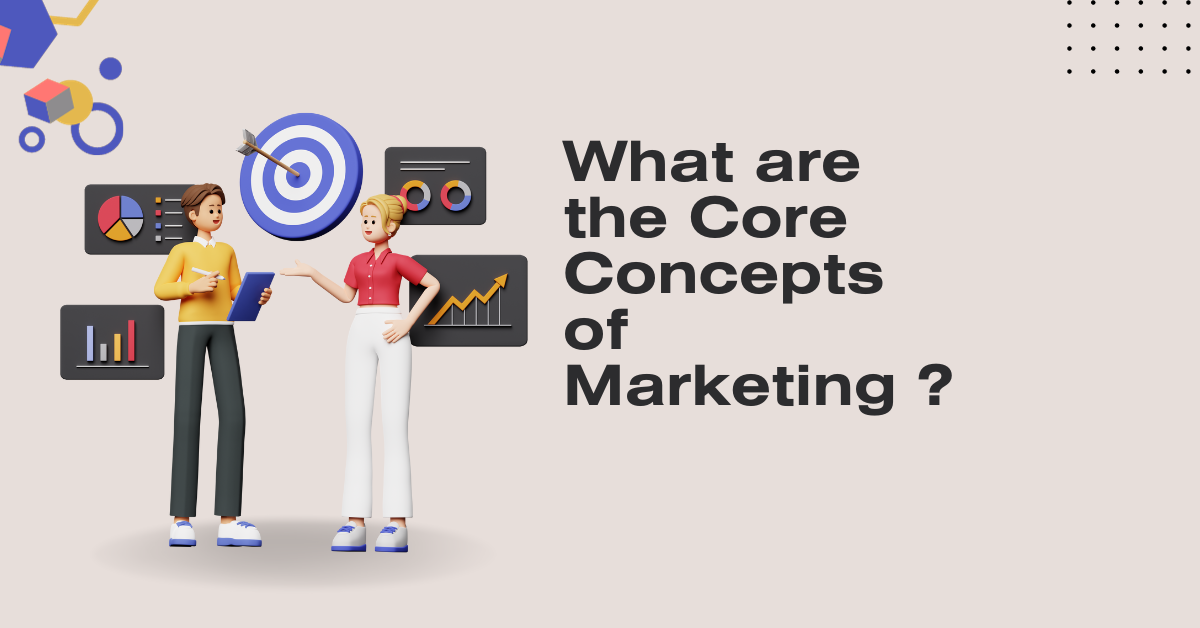
Marketing is a dynamic and ever-evolving field that plays a pivotal role in the success of businesses and organizations. It involves a complex set of strategies, tactics, and principles designed to attract, engage, and retain customers. To master the art of marketing, it is essential to grasp the core concepts that underpin this discipline. In this comprehensive guide, we will explore the fundamental principles and strategies that define modern marketing.
Chapter 1: The Marketing Mix
The 4Ps: Product, Price, Place, and Promotion
The foundation of marketing lies in the 4Ps, which are Product, Price, Place, and Promotion. These elements encompass the core components of any marketing strategy.
-
Product: At the heart of any marketing effort is the product itself. Understanding your product and its unique selling points is essential. Marketers need to identify the features, benefits, and differentiators that make their product stand out in the market.
-
Price: Setting the right price for a product is crucial. This involves considering production costs, competitive pricing, and the perceived value of the product to the customer. Price directly influences consumer behavior and profitability.
-
Place: Also known as distribution, ‘place’ refers to the channels through which products are made available to consumers. Whether it’s through physical stores, e-commerce, or other means, the distribution strategy affects accessibility and convenience for customers.
-
Promotion: Promotion involves the marketing activities aimed at creating awareness and interest in the product. This includes advertising, public relations, social media marketing, and other tactics designed to engage and persuade the target audience.
The Extended Marketing Mix: 7Ps
In addition to the 4Ps, service-based businesses incorporate three additional elements, creating the 7Ps:
-
People: In service marketing, the employees and customer interactions are crucial. The people element focuses on training, customer service, and ensuring that employees reflect the brand positively.
-
Processes: Effective processes are essential for delivering consistent service quality. This concept involves streamlining internal operations to enhance the customer experience.
-
Physical Evidence: For services, the environment in which the service is delivered is a part of the marketing mix. This includes the appearance of facilities, branding, and other tangible elements that influence customer perceptions.
Chapter 2: Target Audience and Market Segmentation
Identifying and Understanding Your Audience
Effective marketing begins with a deep understanding of the target audience. This understanding helps create tailored marketing strategies that resonate with potential customers.
-
Demographics: Demographic information such as age, gender, income, and education level can provide valuable insights into your audience’s characteristics and preferences.
-
Psychographics: Understanding the psychographics of your audience involves analyzing their values, attitudes, lifestyles, and interests. This data is essential for creating content that connects on a personal level.
-
Behavioral Factors: Analyzing consumer behavior helps in predicting purchasing decisions. This can include previous purchasing patterns, brand loyalty, and buying frequency.
Market Segmentation
Market segmentation is the process of dividing a broader market into smaller, more manageable segments. This enables marketers to tailor their strategies to specific groups of consumers.
-
Geographic Segmentation: Dividing the market based on location is essential for products or services with regional variations or local targeting.
-
Demographic Segmentation: This approach categorizes the market by demographics like age, gender, income, and education.
-
Psychographic Segmentation: Segmentation by lifestyle, values, and attitudes allows for more personalized marketing campaigns.
-
Behavioral Segmentation: This approach segments the market based on buying behavior and patterns.
Chapter 3: Consumer Behavior
Understanding the Buying Process
Consumer behavior is a critical aspect of marketing. It involves understanding the steps consumers take before making a purchasing decision:
-
Problem Recognition: The process often begins when a consumer identifies a need or problem they want to solve.
-
Information Search: Once the problem is recognized, consumers seek information about potential solutions. This could involve online research, word-of-mouth, or other sources.
-
Evaluation of Alternatives: Consumers typically evaluate multiple options and compare them in terms of features, benefits, and price.
-
Purchase Decision: After the evaluation, the consumer makes a decision to purchase the chosen product or service.
-
Post-Purchase Evaluation: After making a purchase, consumers assess their satisfaction. Positive experiences lead to brand loyalty and repeat business.
Factors Influencing Consumer Behavior
Several factors influence consumer behavior:
-
Cultural Factors: Culture, subculture, and social class influence consumer values and behaviors.
-
Social Factors: Social groups, family, and social networks have a significant impact on consumer decisions.
-
Personal Factors: Individual characteristics, such as age, occupation, lifestyle, and personality, also play a role.
-
Psychological Factors: Perception, motivation, and learning processes influence consumer choices.
Chapter 4: Branding and Positioning
The Power of Branding
A brand is more than just a logo or a name; it’s the essence of a company or product. Building a strong brand is essential for long-term success.
-
Brand Identity: This includes the visual elements (logo, colors, typography) and the core message that defines what the brand stands for.
-
Brand Image: The way customers perceive your brand is crucial. Positive brand image fosters trust and loyalty.
-
Brand Equity: Strong brands have high brand equity, which means they can command higher prices and customer loyalty.
Positioning Your Brand
Positioning is the process of establishing how your brand is perceived in the minds of consumers relative to competitors.
-
Unique Selling Proposition (USP): A unique selling proposition is what sets your product or service apart from the competition. It’s the reason why consumers should choose your brand.
-
Market Segmentation: Understanding your target audience allows you to tailor your brand message to specific segments, resonating with their needs and desires.
-
Brand Messaging: Effective brand messaging communicates your brand’s value and resonates with your target audience.
Chapter 5: Marketing Research
The Role of Marketing Research
Marketing research is the systematic gathering, recording, and analyzing of data to provide insights and inform marketing decisions.
-
Market Analysis: Understanding the market is essential for identifying opportunities and potential threats. It involves studying market size, growth, and trends.
-
Competitor Analysis: Knowing your competition is crucial. This includes identifying their strengths, weaknesses, and strategies.
-
Consumer Insights: Gaining insights into consumer behavior, preferences, and needs is essential for developing effective marketing strategies.
The Research Process
-
Problem Definition: Clearly defining the problem or objective is the first step in the research process.
-
Data Collection: This can involve surveys, interviews, observations, or the analysis of existing data.
-
Data Analysis: The collected data is then analyzed to draw conclusions and make informed decisions.
-
Actionable Recommendations: Based on the research findings, marketers can formulate strategies and make informed decisions to improve their marketing efforts.
Chapter 6: Marketing Channels
The Importance of Distribution
Distribution channels are the paths through which products or services reach customers. The choice of distribution channel has a significant impact on a company’s reach and accessibility.
-
Direct Distribution: Selling directly to consumers through a company’s website or physical stores allows for more control over the customer experience.
-
Indirect Distribution: Utilizing intermediaries such as retailers or wholesalers can extend the reach of products but may reduce control.
-
Online Distribution: E-commerce has become a dominant distribution channel, allowing for global reach and easy accessibility.
Multi-Channel Marketing
Many companies use a combination of distribution channels, known as multi-channel marketing. This approach ensures that products or services are available through various avenues, catering to diverse customer preferences.
Chapter 7: Marketing Strategy
Setting Clear Objectives
A well-defined marketing strategy begins with clear objectives. These objectives should be specific, measurable, achievable, relevant, and time-bound (SMART).
-
Increasing Sales: Many marketing strategies aim to increase product or service sales.
-
Building Brand Awareness: In some cases, the primary goal is to enhance brand recognition and recall.
-
Expanding Market Share: Companies may strive to gain a larger share of the market by competing with existing competitors.
-
Launching New Products: Introducing new products or services requires a strategic approach to create interest and demand.
Tactical Planning
Once objectives are established, a marketing strategy includes the development of tactics to achieve those goals. These can include advertising campaigns, content marketing, social media initiatives, and more.
Chapter 8: Digital Marketing
The Digital Landscape
Digital marketing is a rapidly growing field, and it’s essential for businesses to have a digital presence.
-
Website: A well-designed website is often the hub of a digital marketing strategy.
-
Search Engine Optimization (SEO): Optimizing content for search engines ensures that your website ranks well in search results.
-
Social Media Marketing: Leveraging social media platforms for brand promotion and engagement is a powerful tool.
-
Content Marketing: Creating valuable content, such as blogs, videos, and infographics, can attract and retain customers.
Email Marketing
Email marketing is a direct and cost-effective way to communicate with customers.
-
Building and Segmenting Email Lists: Maintaining a clean and well-segmented email list helps deliver relevant content to subscribers.
-
Personalization: Personalized email content increases open and click-through rates.
-
Automation: Automation allows for the delivery of targeted messages at the right time.
Chapter 9: Marketing Ethics
Ethical Considerations in Marketing
Ethical marketing practices are essential for building trust and maintaining a positive brand image.
-
Honesty and Transparency: Providing accurate and transparent information to consumers is fundamental.
-
Data Privacy: Respecting and protecting customer data is crucial.
-
Consumer Welfare: Marketing should not promote harmful or unethical behavior.
-
Environmental Responsibility: Sustainable and eco-friendly practices are becoming increasingly important to consumers.
Chapter 10: Marketing Metrics and ROI
Measuring Success
Marketing efforts need to be evaluated to determine their effectiveness.
-
Key Performance Indicators (KPIs): Identifying and monitoring KPIs, such as website traffic, conversion rates, and customer acquisition cost, helps assess performance.
-
Return on Investment (ROI): Calculating the ROI allows marketers to understand the profitability of their marketing campaigns.
-
Marketing Analytics Tools: Utilizing analytics tools provides data-driven insights for decision-making.
Chapter 11: Marketing in the Future
The Evolving Landscape
The marketing landscape is constantly changing, driven by technological advancements, shifts in consumer behavior, and economic developments.
-
Artificial Intelligence: AI and machine learning are being used to personalize marketing efforts and analyze data on a massive scale.
-
Augmented Reality (AR) and Virtual Reality (VR): AR and VR are being harnessed for immersive marketing experiences.
Read More :- Best Digital Marketing Agency in Noida
-
E-commerce Growth: E-commerce continues to grow, requiring innovative marketing strategies.
-
Sustainability and Social Responsibility: Consumers are increasingly conscious of a brand’s social and environmental impact.
Conclusion
Marketing is a multifaceted discipline that involves understanding your product, identifying your target audience, and crafting strategies to connect the two effectively. The core concepts of marketing, including the marketing mix, market segmentation, consumer behavior, branding, and ethical considerations, are crucial for any marketer to grasp. As technology continues to evolve, so too will the field of marketing, presenting new challenges and opportunities for businesses and marketers alike. To succeed in this dynamic landscape, it’s essential to stay informed, adapt to changes, and continue to refine marketing strategies based on these core concepts.



